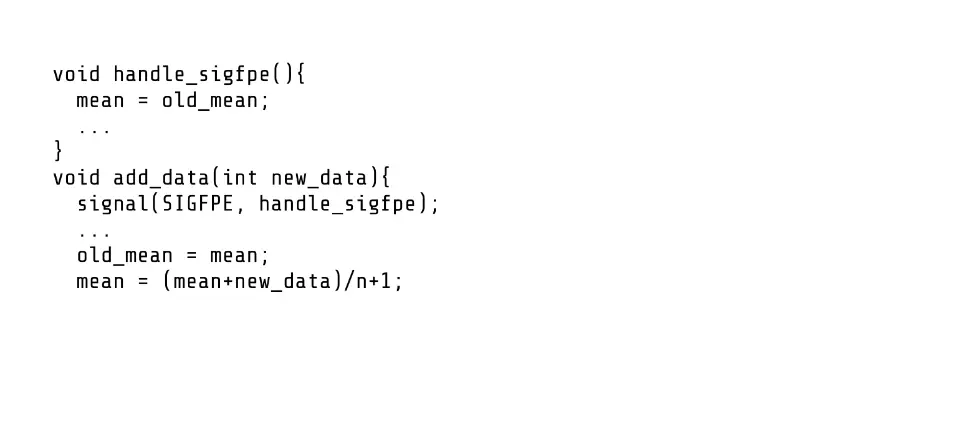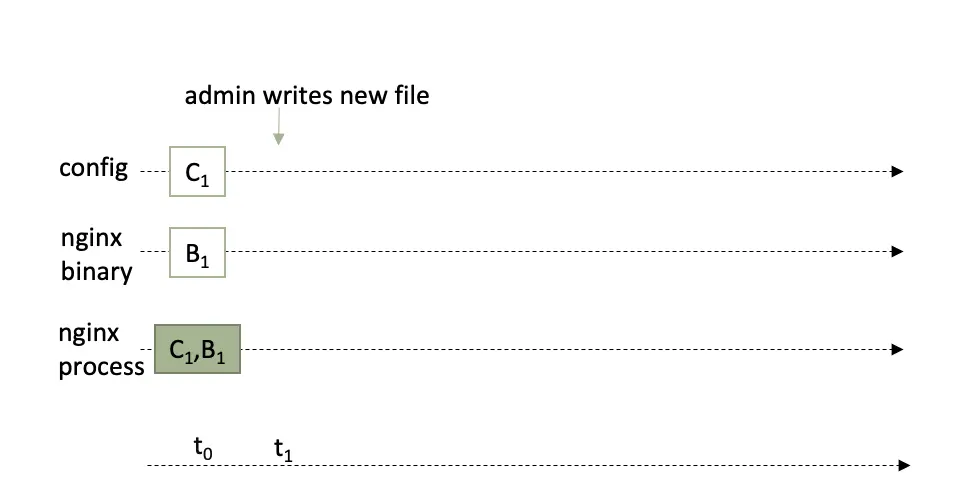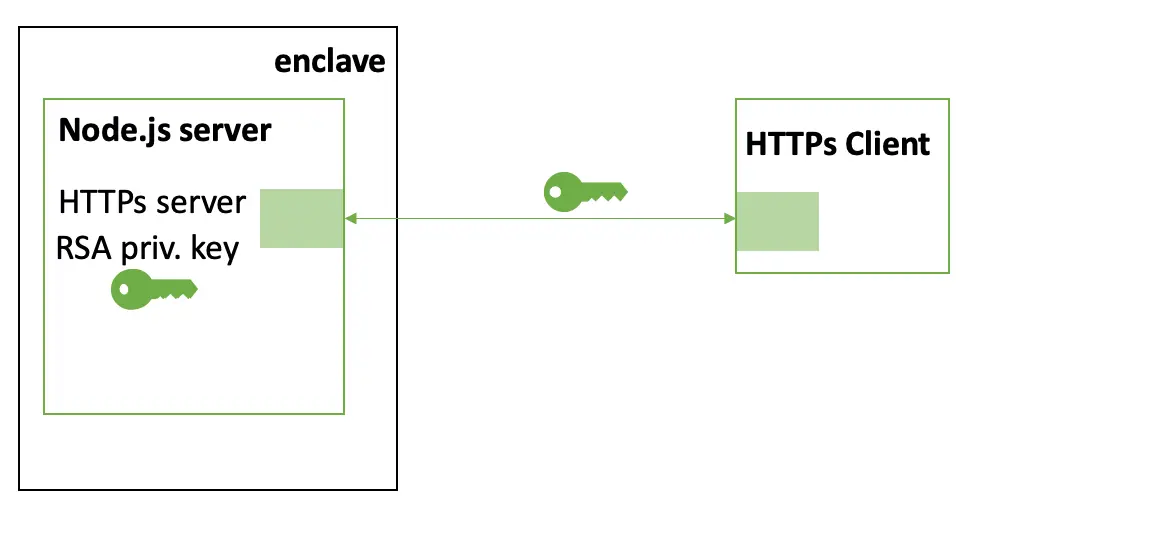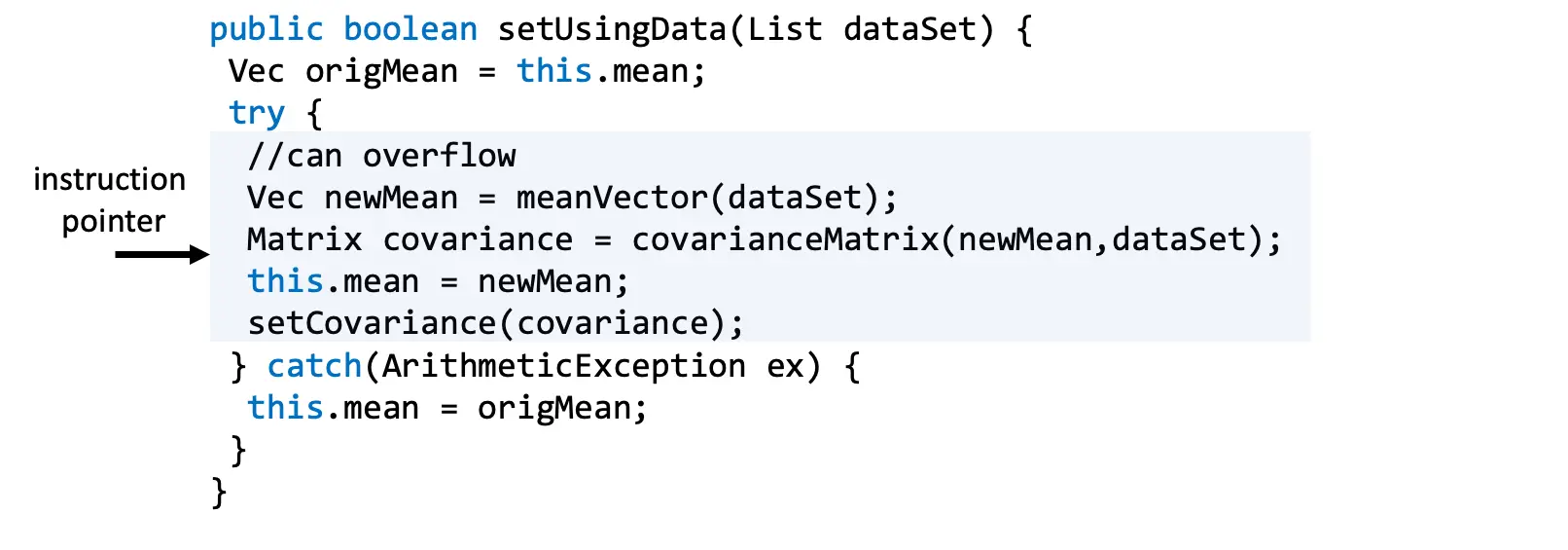How Does It Work?
Intel SGX provides a user-level abstraction called enclaves to protect sensitive data and code execution. In the SGX threat model, the operating system (OS) is untrusted and programs that were written for the traditional model with a trusted OS cannot run inside the enclaves (e.g., syscall instruction is illegal inside the enclave). So, programmers can either rewrite applications to run in the enclave using a small trusted runtime, or use lift-and-shift solutions that deploy a trusted library OS to bridge the gap.
In the SGX, the untrusted OS is still responsible for enclave management (like process management) including the signal delivery. Further, SGX runtimes and library OSes which interface with the OS typically support signal delivery to the enclaves. We show that a malicious OS can send fake signals and trick the enclaves into arbitrarily executing signal handlers that have global effects.
Let us look at an example:
The program below computes the mean based on the input data and handles an sigfpe. If there was an exception (e.g., overflow) during the computation, the function discards the new data and reverts the mean back to the old mean. An attacker (malicious OS) can inject sigfpe when this program runs to force the program to always execute the exception handling logic even when the data was valid. By doing this, the OS manages to trick the enclave into never updating the mean, thus compromising its integrity.

Usually, the OS injects sigfpe to processes if the hardware notifies if of a hardware exception (e.g., divide-by-zero, overflow). Apart from signals like sigfpe which are directly linked to hardware exceptions, the OS also supports inter-process exceptions (e.g., sighup, sigusr1). We show that the OS can also compromise SGX enclaves using these signals.
Case Studies
Nginx
By default, Nginx allows a system administrator to upgrade its configuration (C1, C2 in the animation) and binaries (B1, B2 in the animation) using signals (sighup and sigusr1) without degrading the uptime of the server. We use a malicious OS to inject these signals to an Nginx server executing inside an SGX enclave. This forces the enclave to rollback the configuration (time t5) and binary (time t7) after an administrator has upgraded it. This exploit will undo any performance and security improvements provided by the new binary and configuration and can be used by the OS to bring back old security bugs.

Node.js
Node.js starts a debug web socket when it receives sigusr1. We inject sigusr1 from the malicious OS, and force a Node.js HTTPs server executing inside an SGX enclave to open a debug socket. We connect to this socket using Google Chrome’s debugger and leak the RSA private keys used for TLS in HTTPs.

Multi-Normal Distribution
JSAT, a statistical analysis tool for machine learning applications, implements a MultiVariateNormal class that can be used to create a Multivariate Gaussian distribution.
The class implements a function that updates the mean and covariance of the distribution using the setUsingData function. Like in our first example, this function discards any data that causes an ArithmeticException. Java runtime converts all sigfpe from the OS to an ArithmeticException. We train a Learning Vector Quantization (LVQ) with Multivariate Gaussian distribution as a local classifier in an SGX enclave. Using the malicious OS, we inject sigfpe 240 times to drop the error rate of the classifier from 0% to 66%.

Analysis
We analysed 8 runtimes (Intel SGX SDK, Open Enclave, Teaclave SGX-SDK, Asylo, Rust EDP, GoTEE, Enarx, and EGo) and 6 library OSes (Gramine, Scone, EnclaveOS, EdgelessRT, MystikOS, and Occlum). We find that 3/8 runtimes (Open Enclave, Teaclave SGX-SDK, and Asylo) and 4/6 library OSes (Gramine, Scone, EnclaveOS, and Occlum) are susceptible to Sigy because they do not detect the fake signals injected by the OS.
We analyzed the signal delivery mechanism and handlers for programs written in 9 languages (C, C++, Java, Python, Go, JavaScript, Rust, Julia and Wasm) to observe their behavior in enclaves. Of the 9 languages we study, 8 (C, C++, Java, Python, Go, JavaScript, Rust, and Julia) offer language constructs for programs to register custom handlers.
So, programs written in any of these languages that have signals developed when executed in one of the 7 vulnerable runtime/library OSes might be vulnerable to Sigy.
Affected Software
All Intel SGX enclaves that execute with one of our 7 affected runtimes or library OSes (Open Enclave, Teaclave SGX-SDK, Asylo, Gramine, Scone, EnclaveOS, and Occlum).
FAQ
Q: Does Sigy affect all versions of SGX?
- Yes, Sigy affects all versions of SGX, if the enclaves run in one of the 7 affected runtime or library OSes.
Q: Am I affected if I am not using a runtime or library OSes listed in Affected Software?
- We analysed 14 runtimes and library OSes to find the 7 that are vulnerable to Sigy. If you use one of the 7 runtimes or library OSes that we analysed and found not vulnerable to Sigy, then you are not affected. If we did not analyse your runtime or library OS, we strongly recommend that you check if it supports signal handling and if it exposes interfaces to the malicious OS to propagate signals to enclaves. If yes, then the runtime or library OS is vulnerable to Sigy.
Q: As an SGX enclave developer, how do I protect myself from Sigy?
- If you are using Gramine, then Sigy is patched in commit a390e33. For other runtimes and library OSes, you can check with the respective vendors for a fix.
- Alternatively, if your enclave application was written in one of the 8 programming languages that offer signal handling constructs, you can analyse the application to check if there are vulnerable handlers that have global effects. Then, if possible, rewrite the signal handlers to mitigate Sigy.
Q: As a runtime or library OS vendor, how do I mitigate Sigy?
- Sigy uses signals that are a result of hardware exceptions (e.g.,
sigfpe) and other inter-process signals (e.g.,sighup,sigusr1) to compromise enclaves. SGX2 adds hardware support to store exit information about hardware exceptions in the enclave’s protected state save area (SSA). Runtimes and library OSes should be modified to always check this information before propagating the signals due to hardware exceptions to the enclave. - For inter-process signals, runtimes and library OSes that support multi-process enclaves should build a message-passing framework to allow trusted processes in the same enclave to send signal information to each other. If, for functionality, the enclaves require a signal from outside the enclave processes (e.g., administrators in Nginx or Node.js), there is no defense against Sigy.
Q: Is Sigy a side-channel attack?
- No. Sigy is not a side-channel attack.
Q: How is this an Ahoi Attack?
- Sigy abuses signals, a notification mechanism, to compromise SGX enclaves making it an Ahoi attack.
Q: Why the name Sigy?
- Sigy is a wordplay on “signal,” which we use to compromise SGX enclaves.
Authors
Responsible Disclosure
We informed all the 7 impacted runtimes and library OSes from September 2023 to January 2024. All the vendors of the runtimes and library OSes acknowledged that this is an issue.
CVE
Sigy is tracked under the following CVEs:
Acknowledgments
Thanks to the developers of Gramine, Scone, Open Enclave, Teaclave, Asylo, Occlum, and EnclaveOS for their discussion and engagement during the disclosure process.